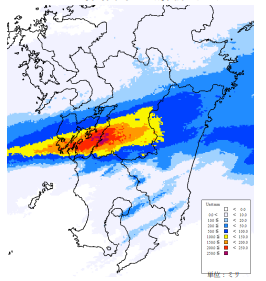
Fujitsu weather forecasting supercomputer
Fujitsu today announced it has delivered a supercomputer to the Japan Meteorological Agency (JMA) in Tokyo for forecasting “linear rainbands,” which can trigger heavy rain causing landslides and flooding. The JMA said the system will start operations tomorrow.
The system is based on Arm-based FUJITSU Supercomputer PRIMEHPC FX1000 hardware, which has the same A64FX CPU as the supercomputer Fugaku, jointly developed by RIKEN Center for Computational Science and Fujitsu and currently ranked no. 2 on the TOP500 list of the world’s most powerful supercomputers.
With a theoretical peak performance of about 31.1 PFLOPS, the new system would be ranked approximately no. 14 on the TOP500 list. It consists of 24 racks (12 racks each for the main and sub systems and the storage system consists of high-speed storage with a total capacity of 42.3 petabytes.
Fujitsu said the system is intended to improve preparedness for heavy rain events and offer earlier warnings in case of disasters.
“Heavy rains are often triggered by linear rainbands, a weather phenomenon that can occur when cumulonimbus clouds slowly move or remain for several hours over the same area,” Fujitsu said in its announcement. “To this end, an early prediction of the occurrence of linear rainbands plays an essential role in the prevention and mitigation of rain-related disasters.”

Map of linear rainband in Japan, July 2020 (credit: JMA)
JMA has been developing linear rainband forecasting technology since June 2022 using Fugaku and plans to leverage the results in the development of the new system. It will be installed at a Fujitsu data center equipped with safeguard mechanisms against various disasters including earthquakes and flooding to support business continuity through stable operation management.
Moving forward, Fujitsu will continue to support the JMA’s activities, including its observation and forecasting technologies such as JMA’s large-scale central “AMeDAS” system (“Automated Meteorological Data Acquisition System”).




